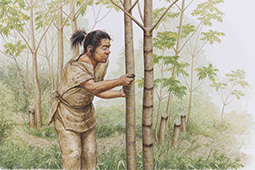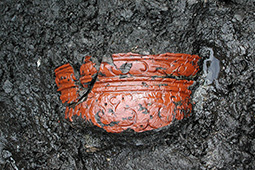May 2022
- English
- 日本語
Red Lacquerware from the Jomon Period

A roughly 7,200-year-old lacquered comb discovered at the Mibiki archeological site in Ishikawa Prefecture 
A roughly 3,000-year-old lacquered basket discovered at the Korekawa-Nakai archaeological site in Hachinohe City, Aomori Prefecture

Roughly 3,000-year-old lacquered pottery discovered at the Korekawa-Nakai archaeological site in Hachinohe City, Aomori Prefecture 
Illustration of lacquer tapping during the Jomon period (illustrated by Ishii Reiko) 
A roughly 3,000-year-old lacquered wooden vessel discovered at the Korekawa-Nakai archaeological site

The history of lacquer use in Japan started during the Jomon period. We asked Associate Professor Kudo Yuichiro of Gakushuin Women’s College about the lacquerware made at that time.

The 13,000-year period from 16,000 years ago to 2,900 years ago in Japan is known as the Jomon period. This was a time when people began to live settled lives and sustained themselves by collecting plant foods, fish and shellfish, as well as hunting animals. But recent research has also shown that people cultivated plants like chestnut and soybean. It was a time when not only stone implements but also much earthenware was made. The name of the period comes from the cord-marked pattern (jomon in Japanese) that is pressed into such earthenware.
During the Jomon period, lacquerware was also made alongside earthenware in various regions. Researchers have found lacquer trees dating from the beginning of the Jomon period (around 12,600 years ago). After that, from around 7,500 years ago, people started making various utensils by using sap from the lacquer trees.

Associate Professor Kudo Yuichiro of the Department of Japanese Studies, Faculty of Intercultural Studies, Gakushuin Women’s College, who is surveying and researching the use of plants during the Jomon period, explains, “It has been confirmed that fragments of a lacquered comb discovered at the Kamikuzuro Nakaya archeological site in Toyama Prefecture and the Mibiki archeological site in Ishikawa Prefecture are about 7,500 to 7,200 years old. At the present time, these are among the oldest remains of lacquerware products in Japan and, it is thought, the world. In any case, a culture of lacquer use had undoubtedly developed on the Japanese islands between 7,500 and 6,000 years ago.”
In addition, lacquerware from the Jomon period has been unearthed in many locations in Japan. For example, red-lacquered wooden plates and red pigments from about 5,500 years ago have been found at the Sannai Maruyama archeological site of one of Japan’s biggest Jomon settlements in Aomori Prefecture, which is part of the world heritage Jomon Prehistoric Sites in Northern Japan. Already 7,000 years ago, it has been confirmed that the Jomon people had artistically combined red and black colored lacquer and used inlay techniques.* In the final Jomon period, they were also making things such as rantai shikki,** so the Jomon people had a highly sophisticated lacquer culture.

You get a skin rash if you come in contact with the lacquer sap. Moreover, collecting the sap is very laborious (see here). So why did the Jomon people make lacquerware despite such labor and risk?
“Red carries magical meaning as a symbol of the life force, but I suppose that lacquerware painted with red pigments was also considered ‘beautiful.’ The people of the Jomon period collected red iron oxide and cinnabar from nature and had a preference for making red lacquerware. I don’t think there’s any paint in the natural world that is as beautiful and graceful as lacquer.”
If the only purpose is to enhance durability and waterproofness, then there is no need to make it red. Just as Kudo says, the main goal might have been aesthetic. Together with black, red remains a color emblematic of Japanese lacquerware. Reconstructing the red lacquerware excavated from the Korekawa-Nakai archaeological site has revealed a level of perfection that might allow authentic Japanese cuisine to be served on it even today. This might be telling us that the lives of people who lived in Japan thousands of years ago were much stabler and more fulfilling that we tend to imagine.

* Ornamental technique that makes patterns stand out by using clay of a different color from the base clay
** Lacquered basket of woven sasa (bamboo grass)

